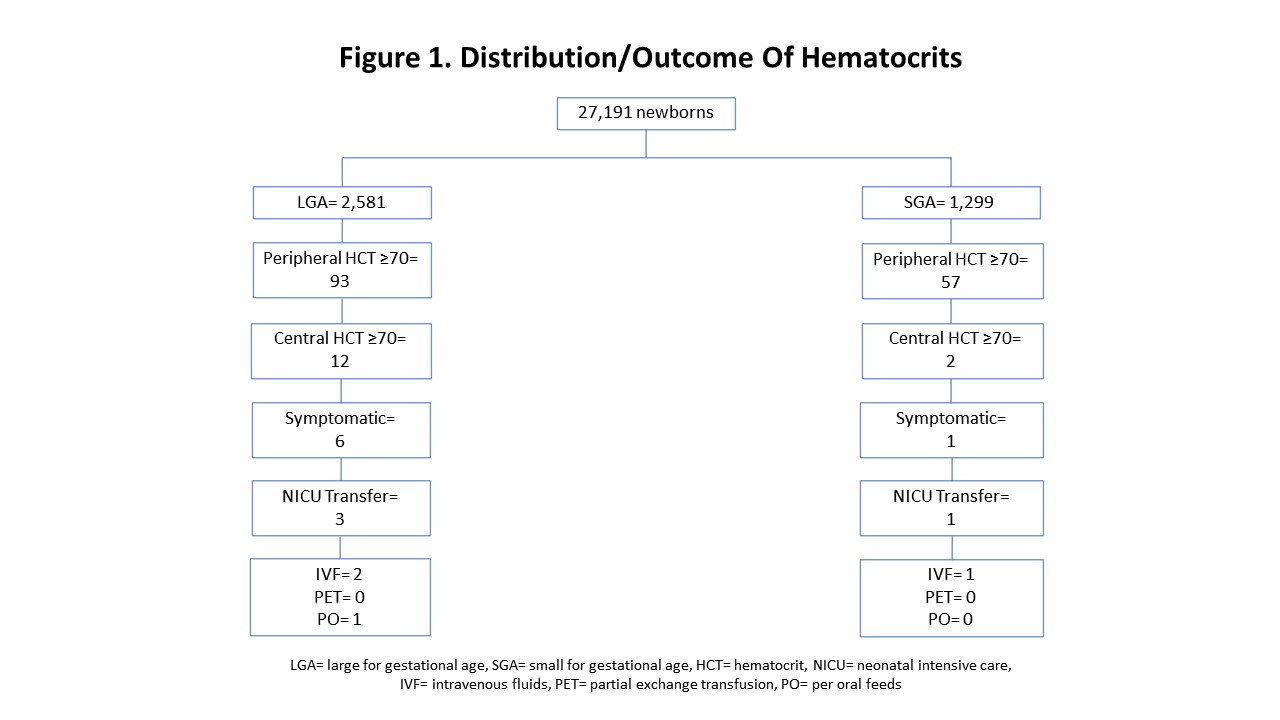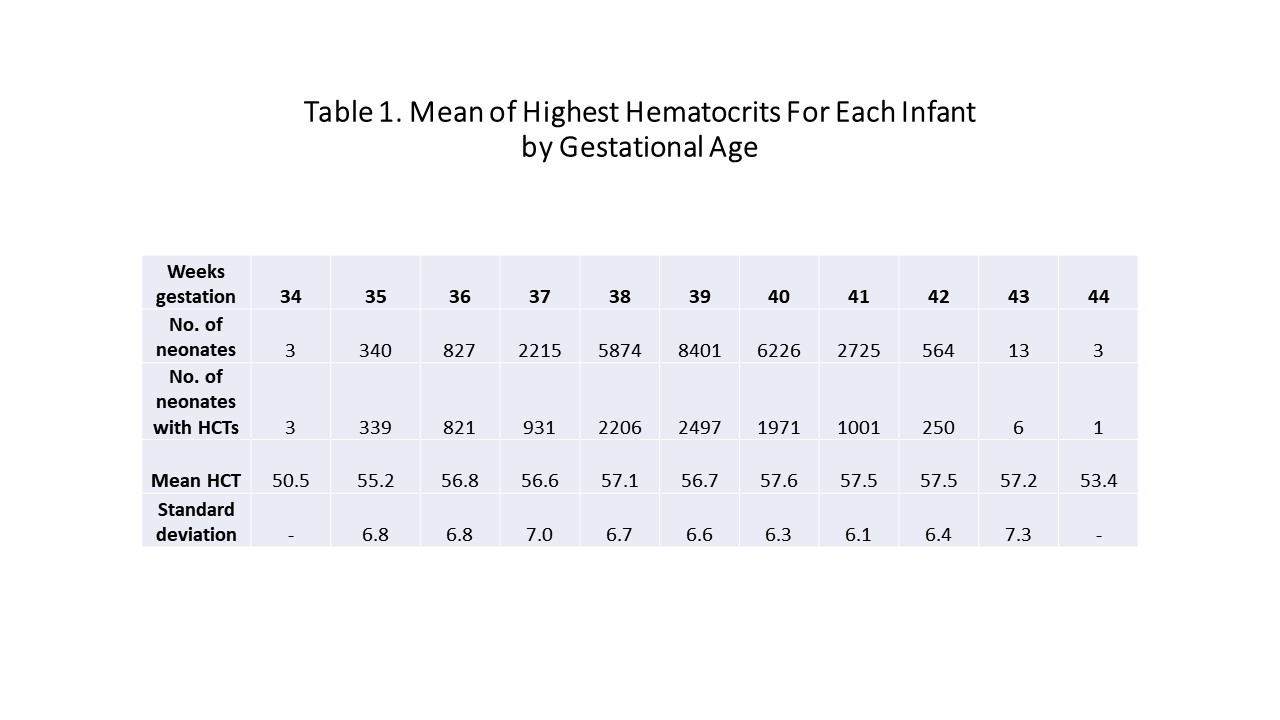Neonatal General
Category: Abstract Submission
Neonatology General 3
383 - Utility Of Routine Hematocrit Screening In Large And Small For Gestational Age Newborns
Friday, April 22, 2022
6:15 PM - 8:45 PM US MT
Poster Number: 383
Publication Number: 383.133
Publication Number: 383.133
MURALEEDHARAN SIVARAJAN, University of Texas Southwestern Medical School, Fairview, TX, United States; Joseph H. Schneider, University of Texas Southwestern Medical School, Bryn Mawr, PA, United States

MURALEEDHARAN SIVARAJAN, MD, MRCPI, DCH
Clinical Asst. Professor Pediatrics
University of Texas Southwestern Medical School
Fairview, Texas, United States
Presenting Author(s)
Background: Screening for polycythemia with hematocrits (HCT) is part of at-risk protocols for large and small for gestational age (LGA, SGA) newborns delivered at Parkland Hospital in Dallas, TX. With >12,000 annual deliveries, this amounts to a substantial number of tests. Infants with actionable results (HCT ≥70 or ≥65 with symptoms) may receive intravenous fluids (IVF) or a partial exchange transfusion (PET). However, there is paucity of evidence that PET improves long-term outcomes.
Objective: Investigate how often HCT screening in LGA/SGA newborns yields actionable results and the treatments received.
Design/Methods: Retrospective chart review of point of care hematocrits for LGA/SGA newborn admissions as identified by Olsen growth curves, in Parkland mother-baby unit from July 2016 to November 2018. Hematocrits ≥70 were chart reviewed as they were most likely to receive interventions.
Results: 27,191 newborns from 34 to 44 weeks gestational age (Figure 1) were analyzed. Mean gestation was 39 weeks and mean weight was 3360 grams, with 13,682 males and 13,509 females. 78% were Hispanic, 15% Black, 3% Caucasian and 4% Other.
12,433 heel stick and central HCTs were done on 10,026 LGA, SGA and AGA (appropriate for GA) newborns with values ranging from 28 to 78%. Mean of highest HCTs tended to increase with gestational age (Table 1). Mean of highest HCTs were 57.8, 56.7 and 57.6 for SGA, AGA and LGA respectively (Figure 2).
Among 2,581 LGA newborns (Figure 1), only 12 central HCTs were ≥70, with 6 being symptomatic. Of the latter, 3 were transferred to the neonatal intensive care unit (NICU). 2 were treated with IV fluids and 1 with oral feeds. All symptoms were minor (jitteriness, temperature instability, hypoglycemia, grunting, transient tachycardia).
Among 1,299 SGA newborns (Figure 1), only 2 had central HCT ≥70. 1 was symptomatic (excessively sleepy) and transferred to the NICU and treated with oral feeds.
None of the LGA/SGA newborns with HCTs ≥70 had manifestations of sequelae of polycythemia on discharge. None received PET.Conclusion(s): Routine screening with HCTs in LGA/SGA newborns rarely yields actionable abnormal results and IVF/PET treatments are extremely rare. Clinical signs and symptoms may be used to prompt HCT checks rather than blanket screening, saving valuable resources, procedural pain, family distress, and potential separation of the mother-baby dyad.
Figure 1. Distribution/Outcome Of Hematocrits
Table 1. Mean of Highest Hematocrits For Each Infant by Gestational Age
Objective: Investigate how often HCT screening in LGA/SGA newborns yields actionable results and the treatments received.
Design/Methods: Retrospective chart review of point of care hematocrits for LGA/SGA newborn admissions as identified by Olsen growth curves, in Parkland mother-baby unit from July 2016 to November 2018. Hematocrits ≥70 were chart reviewed as they were most likely to receive interventions.
Results: 27,191 newborns from 34 to 44 weeks gestational age (Figure 1) were analyzed. Mean gestation was 39 weeks and mean weight was 3360 grams, with 13,682 males and 13,509 females. 78% were Hispanic, 15% Black, 3% Caucasian and 4% Other.
12,433 heel stick and central HCTs were done on 10,026 LGA, SGA and AGA (appropriate for GA) newborns with values ranging from 28 to 78%. Mean of highest HCTs tended to increase with gestational age (Table 1). Mean of highest HCTs were 57.8, 56.7 and 57.6 for SGA, AGA and LGA respectively (Figure 2).
Among 2,581 LGA newborns (Figure 1), only 12 central HCTs were ≥70, with 6 being symptomatic. Of the latter, 3 were transferred to the neonatal intensive care unit (NICU). 2 were treated with IV fluids and 1 with oral feeds. All symptoms were minor (jitteriness, temperature instability, hypoglycemia, grunting, transient tachycardia).
Among 1,299 SGA newborns (Figure 1), only 2 had central HCT ≥70. 1 was symptomatic (excessively sleepy) and transferred to the NICU and treated with oral feeds.
None of the LGA/SGA newborns with HCTs ≥70 had manifestations of sequelae of polycythemia on discharge. None received PET.Conclusion(s): Routine screening with HCTs in LGA/SGA newborns rarely yields actionable abnormal results and IVF/PET treatments are extremely rare. Clinical signs and symptoms may be used to prompt HCT checks rather than blanket screening, saving valuable resources, procedural pain, family distress, and potential separation of the mother-baby dyad.
Figure 1. Distribution/Outcome Of Hematocrits

Table 1. Mean of Highest Hematocrits For Each Infant by Gestational Age

